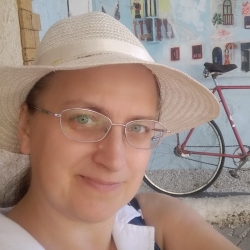
There is / There are
Составила:
преподаватель
английского языка
Воронина М.В.
2017

Оборот there с личной формой глагола to be в английском языке употребляется очень часто и имеет значение есть, имеется, находится, т.е. в тех случаях, когда говорящий хочет подчеркнуть факт наличия (отсутствия) какого-либо предмета или явления, а не место, в котором находится.

Глагол to be в этом обороте может употребляться в единственном и во множественном числе и в разных временных формах
Singular
Present Simple
Plural
There is
Past Simple
There was
There are
Future Simple
There were
There will be
There will be

Если английское предложение начинается с конструкции There is или There are на русский язык такое предложение следует переводить начиная с конца.
There are four books in the bag. –
В сумке четыре книги.

Если в предложении несколько подлежащих, то выбор формы глагола ( is или are ) определяется тем подлежащим, которое стоит первым.
There is a pen, two books and a pencil in the bag .
There are two books, a pen and a pencil in the bag.

Виды предложений
Positive
Present Simple
Negative
There is a child in the room.
Past Simple
Interrogative
There is not a child in the room.
There was a child in the room.
Future Simple
Is there a child in the room?
There was not a child in the room.
There will be a child in the room.
Was there a child in the room?
There will not be a child in the room.
Will there be a child in the room?

Исчисляемые существительные в единственном числе в отрицательной форме употребляется с неопределённым артиклем, а существительное во множественном числе или неисчисляемое существительное – со словом any.
There isn’t a book on the table.
There are not any books on the table.
There is not any water in the bottle.

Отрицательную форму можно образовать также с помощью местоимения no, которое ставится перед существи-тельным. В этом случае существительное употребляется без артикля:
There is no flower in the vase.
There are no cats on the roof.

Exercise 1. Insert is or are.
- There _____ two cups of tea on the table.
- There _____ some milk in the cup.
- There _____ an orange in the salad.
- There _____ six balls in the box.
- There _____ some cheese on the plate.
- There ______ a blue chair at the door.
- There _____ five chicks and a hen on the farm.
- There _____ a table and nine desks in the classroom.
- There _____ a big window to the left of the door.
- There _____ three rooms in our country house.

Exercise 2. Write negative and interrogative sentences.
1.There’s a blackboard in our classroom.
2. There are some English books on the table.
3. There were very many mistakes in your dictation.
4. There was a new grammar in this disk.
5. There was my sandwich on the table.
6. There will be too little ink in my pen to write these notes. 7. There is not enough salt in the food.
8. There were many quiet places in this park.
9.There was little milk in his glass.
10. There are five girls and eight boys in our group.

Exercise 3. Write the sentences in Past Simple and Future Simple:
- There is much snow in winter.
- There are 5 theatres in our city.
- There is no lift in our house.
- There are many new books in our library.
- There is little milk in the bottle.
- There are 3 rooms in our flat.
- There is a map on the wall

Exercise 4. Make up the sentences. Translate them.
1. pears / there / ten / in the / are / bag / .
2. aren’t / pupils / there / classroom / in the / .
3. an egg / on the / there / plate / is / ?
4. on the / there / a / cat / chair / is / white / .
5. a turtle / on / there / isn’t / farm / this / .
6. at the / two / bikes / door / are / there / ?





































